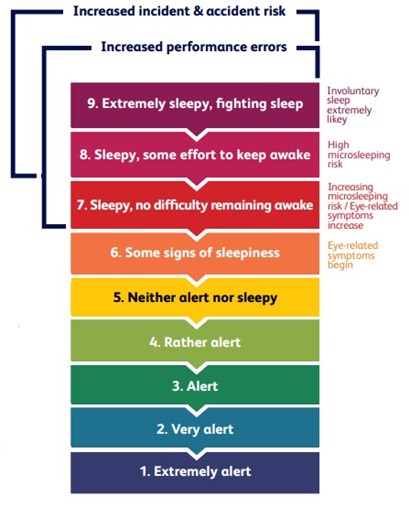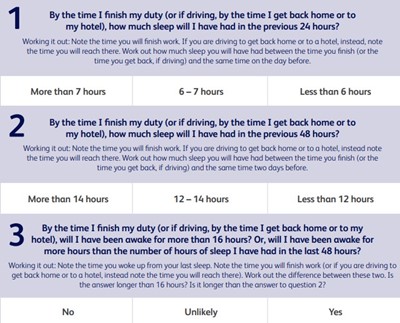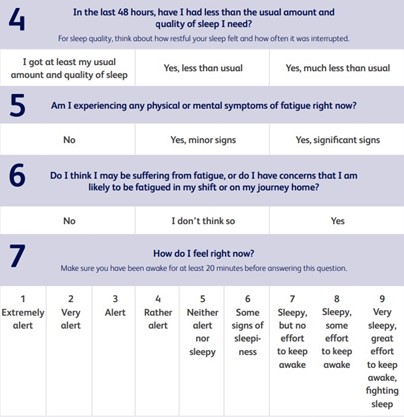12.1 A lack of fatigue reports is not evidence that fatigue is not a problem – it could be evidence that effective fatigue reporting processes are not in place (Jackson, 2008). Additionally, staff may be disincentivised to report fatigue for shift patterns that they consider favourable, e.g. that provide sizeable gaps between blocks of shifts. Over time, staff may be more willing to report fatigue for shifts they consider favourable but are in fact fatiguing if they experience the benefits of less fatiguing shift patterns on their home life and rest days, i.e. less need to recoup sleep. Rail organisations need to encourage the pro-active reporting of fatigue and its precursors including for example long travel times before a shift; noisy lodgings; over-running work; late notice changes etc. Unless the organisation already has an established, effective, well-used safety-concern reporting system which captures pre-cursors to fatigue, it may be necessary to introduce a dedicated fatigue reporting system. A dedicated fatigue reporting system may also raise the profile of fatigue risks amongst staff and emphasise that management are serious about tackling genuine fatigue concerns.
12.2 Staff Fatigue Report Forms (FRF) provide a formal method for collecting data on fatigue and its likely causes and allow staff to suggest possible solutions. They allow staff to report fatigue-related incidents, errors, behaviours, and other concerns. An FRF can collect information on factors which may have contributed to fatigue, for instance workload, travel arrangements, domestic circumstances and so on. Fatigue report forms should therefore include space for staff to suggest corrective actions.
12.3 To encourage a culture of self-reporting of fatigue, dutyholders should have clear, simple, quick, and fair processes for reporting fatigue and the actions required when employees are too fatigued to carry out safety critical tasks. For example, to encourage reporting, forms could be kept on hand in all train cabs, depots etc. They should be easy and quick to complete usually no more than one page long. They should incorporate both tick box questions to allow categorisation and analysis and free text space to allow description of concerns and possible solutions.
12.4 A fatigue reporting system should be supported by the means for managing and responding to reports including acknowledgment and providing feedback on changes made in response to identified fatigue hazards without compromising the anonymity of individuals. Staff may not bother reporting unless they receive feedback on reports they submit, confirming that reports are taken seriously and considered - reasons for any actions taken or not taken as a result of their report should be fed back to reporters.
12.5 FRFs can help to build a picture of fatigue in the operation and should help identify any problem shifts/locations/roles/routes and so on; it can help show any trends over time. This helps ensure that efforts to reduce fatigue are targeted where they are most needed.
12.6 Some possible information organisations may wish to include on fatigue report forms is as follows:
- The reason for the report form e.g. unable to attend work due to fatigue, stood down due to fatigue, an incident or a general fatigue concern.
- Relevant details e.g. name, role, date, time, location, contact details.
- Description of the incident of concern e.g. journey to and from work with postcodes and mode of travel, work activity and activity at time of event, contributing factors (multiple consecutive duties, variation in duty timing, long shift, high/load workload), quality of sleep at home or lodging, health, home/personal issues, start and finish time, etc.
- Any signs of fatigue observed. See Table 12.1 below.
- The individual’s self-assessment of fatigue e.g. via the nine-point Karolinska Sleepiness Scale (KSS) or RSSB mini self-assessment tool. See below and Figures 12.1 and 12.2.
- Any suggestions for fatigue reduction, corrective actions etc.
12.7 These are some suggestions only, and dutyholders should tailor the information collected so it is appropriate to their needs and the degree of risk.
Table 12.1 Signs of Fatigue
| Stage | Signs of fatigue |
|---|---|
| Early signs |
|
| Signs of serious fatigue |
|
Arrangements should be made for a welfare conversation to take place with those showing early signs of fatigue, to determine whether they can continue with their duty. Those showing signs of serious fatigue should not be allowed to continue with their duty.
Source: Reproduced from RSSB (2022) Fitness for Duty and Assessing fatigue: a Good Practice Guide
12.8 It may be relatively simple to identify any ‘problem’ shifts or work patterns / features by for instance asking all staff to take a few seconds to anonymously complete a fatigue rating scale before / during / at the end of a duty, with simple identification of the depot / route / link etc, for immediate deposit in a box in the cab/depot e.g. the nine-point Karolinska Sleepiness Scale (KSS), see Figure 12.1. If you are at KSS Level 7 or above you are more likely to experience microsleeping and make errors, particularly while driving. In this way a large amount of information can be easily and cheaply collected on perceived fatigue in the whole of the operation. Such an approach requires honesty in its use.
Figure 12.1 Nine-point Karolinska Sleepiness Scale (KSS)

Source: RSSB (2022) Helping you manage fatigue risk while on call Good Practice Guidance
Information about sleep before a particular duty could be collected in a self-assessment tool such as that developed by RSSB that can help in decision making. It combines rules of thumb on how much sleep you have had recently and how long you’re likely to be awake, simple fatigue questions and the KSS. This mini self-assessment tool could be included in fitness for duty checks, see Figure 12.2.
Figure 12.2 Mini self-assessment tool


If one or more of your answers is in the right-hand box, you may be fatigued or at risk of fatigue. In this case, you should speak to your manager or on-call contact to discuss options for managing the risk. If you are at KSS Level 7 or above you are more likely to experience microsleeping and make errors, particularly while driving.
Source: RSSB (2022) Helping you manage fatigue risk while on call Good Practice Guidance

